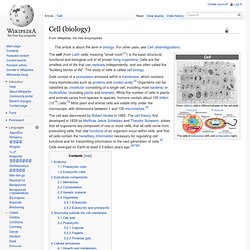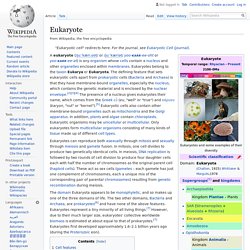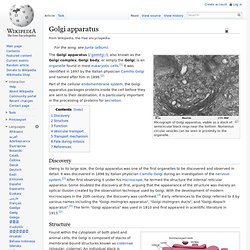

Embryology. Cell biology. Understanding cells in terms of their molecular components.

Knowing the components of cells and how cells work is fundamental to all biological sciences. Appreciating the similarities and differences between cell types is particularly important to the fields of cell and molecular biology as well as to biomedical fields such as cancer research and developmental biology. These fundamental similarities and differences provide a unifying theme, sometimes allowing the principles learned from studying one cell type to be extrapolated and generalized to other cell types. Therefore, research in cell biology is closely related to genetics, biochemistry, molecular biology, immunology, and developmental biology. Processes[edit] Movement of proteins[edit] Endothelial cells under the microscope. Each type of protein is usually sent to a particular part of the cell.
Other cellular processes[edit] Internal cellular structures[edit] Techniques used to study cells[edit] The Biology of Cells. The cell (from Latin cella, meaning "small room"[1]) is the basic structural, functional and biological unit of all known living organisms.

Cells are the smallest unit of life that can replicate independently, and are often called the "building blocks of life". The study of cells is called cell biology. The cell was discovered by Robert Hooke in 1665. The cell theory, first developed in 1839 by Matthias Jakob Schleiden and Theodor Schwann, states that all organisms are composed of one or more cells, that all cells come from preexisting cells, that vital functions of an organism occur within cells, and that all cells contain the hereditary information necessary for regulating cell functions and for transmitting information to the next generation of cells.[5] Cells emerged on Earth at least 3.5 billion years ago.[6][7][8] Anatomy There are two types of cells, eukaryotes, which contain a nucleus, and prokaryotes, which do not. Eukaryote. Eukaryotes can reproduce both asexually through mitosis and sexually through meiosis and gamete fusion.

In mitosis, one cell divides to produce two genetically identical cells. In meiosis, DNA replication is followed by two rounds of cell division to produce four daughter cells each with half the number of chromosomes as the original parent cell (haploid cells). These act as sex cells (gametes – each gamete has just one complement of chromosomes, each a unique mix of the corresponding pair of parental chromosomes) resulting from genetic recombination during meiosis.
Organelle. Mitochondria. Two mitochondria from mammalian lung tissue displaying their matrix and membranes as shown by electron microscopy History[edit] The first observations of intracellular structures that probably represent mitochondria were published in the 1840s.[13] Richard Altmann, in 1894, established them as cell organelles and called them "bioblasts".[13] The term "mitochondria" itself was coined by Carl Benda in 1898.[13] Leonor Michaelis discovered that Janus green can be used as a supravital stain for mitochondria in 1900. Friedrich Meves, in 1904, made the first recorded observation of mitochondria in plants (Nymphaea alba)[13][14] and in 1908, along with Claudius Regaud, suggested that they contain proteins and lipids. Benjamin F. Kingsbury, in 1912, first related them with cell respiration, but almost exclusively based on morphological observations.[13] In 1913 particles from extracts of guinea-pig liver were linked to respiration by Otto Heinrich Warburg, which he called "grana".
Mitochondrial DNA. Electron microscopy reveals mitochondrial DNA in discrete foci.

Bars: 200 nm. (A) Cytoplasmic section after immunogold labelling with anti-DNA; gold particles marking mtDNA are found near the mitochondrial membrane. (B) Whole mount view of cytoplasm after extraction with CSK buffer and immunogold labelling with anti-DNA; mtDNA (marked by gold particles) resists extraction. Golgi apparatus. Micrograph of Golgi apparatus, visible as a stack of semicircular black rings near the bottom.

Numerous circular vesicles can be seen in proximity to the organelle. Part of the cellular endomembrane system, the Golgi apparatus packages proteins inside the cell before they are sent to their destination; it is particularly important in the processing of proteins for secretion. Discovery Owing to its large size, the Golgi apparatus was one of the first organelles to be discovered and observed in detail. It was discovered in 1898 by Italian physician Camillo Golgi during an investigation of the nervous system.[2] After first observing it under his microscope, he termed the structure the internal reticular apparatus. Structure Diagram of the Golgi apparatus 3D Rendering of Golgi Apparatus Found within the cytoplasm of both plant and animal cells, the Golgi is composed of stacks of membrane-bound structures known as cisternae (singular: cisterna).
Function Vesicular transport Transport mechanism.